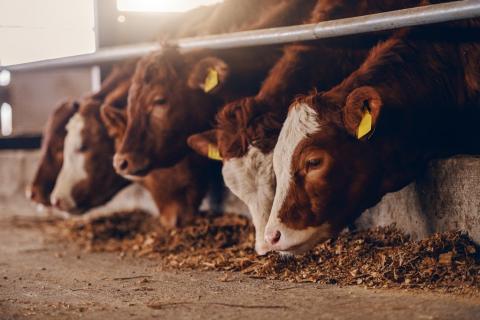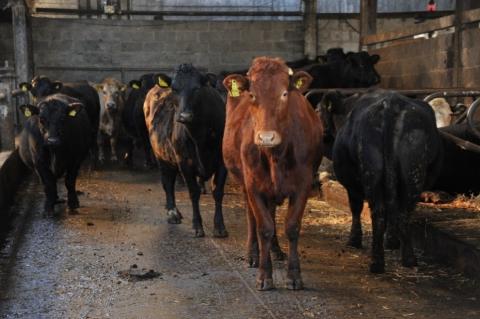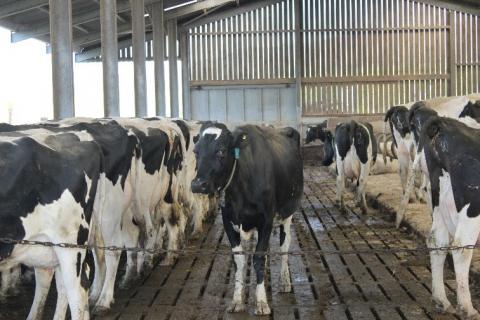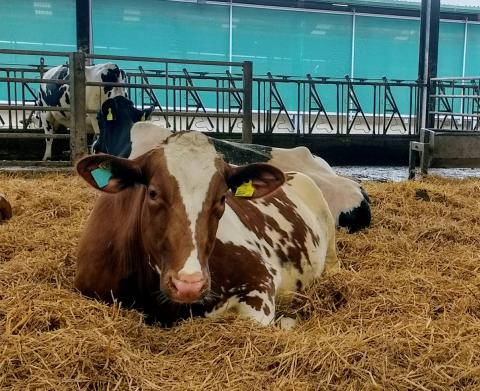17 December 2020
Dr William Stiles: IBERS, Aberystwyth University.
Take home messages:
- Ammonia is a key contributor to air pollution levels, as it can become particulate matter after combination with other pollutant materials from a range of sources.
- Reducing ammonia emission limits both the potential for air pollution and the wider environmental impact associated with nitrogen pollution.
- Losses of ammonia represent losses of valuable farm-production material. This can have an adverse effect on farm business efficiency.
Air pollution is a major environmental health risk, which affects human populations in developed and developing nations alike. Agricultural activities contribute to air pollution through the emission of ammonia, which can combine with other pollutant materials that originate from a range of sources to become fine particulate matter. Particulate matter is a material of key health concern as it can penetrate deeply into the lungs and cause a range of conditions including respiratory and cardiovascular illness and mortality.
In Wales, 93% of ammonia emissions are the result of agricultural activities. Reducing the amount of ammonia emitted from agricultural sources is therefore a necessary action to reduce levels of air pollution nationally. In addition, ammonia pollution can have significant environmental impact, and can lead to reductions in biodiversity, eutrophication, and acidification of soil and aquatic ecosystems.
The loss of ammonia also represents the loss of valuable material from within a farm business. Any nitrogen (N) which is emitted to the environment is N which is not utilised by plants or animals. As such, modifying farm business management to reduce ammonia losses has the potential to benefit human health and wellbeing, to reduce environmental impact, and to increase farm business efficiency.
Farm management to reduce ammonia emissions
The emission of ammonia from agriculture is primarily associated with livestock production and fertiliser management. There are ways in which existing farm management can be modified to reduce the potential for ammonia emission, and these actions range in effectiveness between moderate benefit to significant reductions.
The degree of effectiveness is often related to the size of the intervention. In theory it is possible to almost completely stop ammonia emissions from farm activities, should the necessary investment be made in appropriate technology or infrastructure. But such investment can be sizable and it is accepted that without financial support this may be challenging for many farm business types. Yet, some interventions require only minimal management change, and whilst these may contribute only modest gains, any reduction in emission rates contributes to an overall net benefit. Thus, even for farm businesses where investment may not be possible, small improvements in existing management can still help to achieve emission reduction goals.
The main areas of agricultural activity where strategies for reducing ammonia emissions can be applied are livestock feed, animal housing, manure spreading, manure storage, and non-organic fertiliser use. The options for management in these areas are discussed below.
Livestock feed
The amount of N present in animal feed will affect the amount of N excreted in faeces and urine. Where there is an excess of N in feed, more than can be utilised by the animal, then this will result in high-levels of N in excreta, which can lead to increases in ammonia emissions.
Reducing the amount of protein in livestock diets is an effective strategy for reducing emissions. This action can also influence emission rates in multiple related activity areas, including animal housing, manure storage, and the application of manure to land. This can be up to a 5 - 15% decrease in emissions for every 1% reduction in protein content of feed. For dairy and beef cattle crude protein levels in dry matter should be limited to around 16% and 12% respectively, in order to see reductions in N emission.
The nutrient requirements for livestock also decrease as the age and weight of the animal increases. Improving the precision of feed input via approaches such as phase feeding means the amount of crude protein in diets and animal usage rates can be specifically aligned, reducing unnecessary protein consumption. Furthermore, secondary benefits of reducing protein levels in feed include a reduction in nitrous oxide emissions, a key greenhouse gas, and increased animal N-use efficiency, which are beneficial for general farm management objectives.
Dietary manipulation can also be undertaken through the use of feed additives to reduce emission. For instance the incorporation of a urease inhibitor into feed has been shown to reduce ammonia emissions by up to 50.9%. Incorporating other materials such as tannins and saponins, liquid alum, and maize distiller’s dried grains with solubles (DDGS) may also have a positive effect (circa 45% reduction), but further consideration should be given to additive type, dose, and animal and farm type prior to implementation.
Animal housing - flooring
Manure and urine from livestock emit ammonia when exposed to the air. Strategies to reduce volatilisation of ammonia in animal housing situations centre on reducing the surface area of the excreta material which is exposed to the air and increasing the speed and efficiency of transport of excreta material into safe storage.
Flooring that is slatted or has run-off channels can enable the transport of excreta into storage containment. Perforated flooring, or flooring where dung and urine can pass into storage systems, has significantly less ammonia output than solid floors. This happens because the materials stored in below-floor pits will be subject to reduced air flow across surfaces, which has a positive effect on emissions. Conversely, solid floor systems allow urine and faeces to mix and stagnate. The separation of urine and faeces is also important as this reduces the interaction of urease, which is abundant in faeces, with urinary urea-N, limiting the rate of urea hydrolosis and therefore emissions. Where excreta remains in situ, such as in solid floor situations, building temperature can also play a significant role as heat is a moderating factor in ammonia volatilisation. Urease activity is greatest at 60oC, declining with decreasing temperature. Therefore warmer temperatures will result in greater rates of emission.
In situations where solid flooring is unavoidable, then applying bedding material such as straw can potentially alleviate emissions. Straw bedding reduces ammonia output by providing a physical barrier between urine and the air, and by increasing microbial immobilisation. The addition of extra straw to increase bedding depth, particularly in the wettest/dirtiest areas, will further improve this effect. Caution is still advised with regard to application rate however, as too much bedding could cause the litter temperature to rise resulting in a counterproductive effect. This approach can also reduce emissions at both the storage and the land spreading stages, as solid manure with bedding incorporated has a lower emission potential than slurry. But, this factor may be dependent on choice of land application approach, as whilst true for surface spreading systems, direct injection or other low-emission land application techniques require slurry. In such circumstances, a no bedding-slurry system may offer the greater potential overall. This factor highlights the need to consider all strategies in the context of wider farm management, as there is a high degree of interrelatedness between the different emission areas. As such a ‘whole farm’ strategy is necessary.
Where bedding is applied, different material choices can also influence emission rates. The physical characteristics of bedding material (i.e. absorbency potential) are key in determining efficacy. In a study that considered the influence of a range of bedding (chopped wheat straw, sand, pine shavings, chopped newspaper, chopped corn stalks, and recycled manure solids) it was found that the least absorbent (sand, pine shavings) emitted the least ammonia. This effect was attributed to the density of the bedding material, where once the urine had penetrated the bedding layer, it could pool underneath away from contact with the airstream, limiting atmospheric interaction and therefore emission.
Lastly, increasing the amount of time animals spend outdoors grazing will also reduce the potential for emissions overall from animal housing situations, as urine excreted in field situations is rapidly incorporated and distributed within soil, decreasing volatilisation potential.
Animal housing - infrastructure
In force-ventilated housing scenarios, the application of infrastructure such as air scrubbers can be used to capture ammonia from the air, before it is released to the environment. Such housing is not currently typical for cattle or sheep systems in the UK, as these are more often naturally ventilated, but is more common in high-secure pig or poultry units. Nevertheless, these could be implemented should the need to reduce ammonia output become sufficiently pressing that investment becomes justified.
Air scrubbers employ a range of techniques to capture ammonia. Common approaches include acid scrubbing or biotrickling. Acid scrubbing uses sulphuric acid (H2SO4) to capture ammonia (NH3) through combination, which produces ammonium sulphate ((NH4)2SO4). This material can then be utilised subsequently (in appropriate circumstances) as a fertiliser. Biotrickling, also referred to as bio-scrubbing, uses nitrification and/or denitrification as the capture process. This mimics natural N cycle processes of NH3 conversion to nitrite (NO2), then nitrate (NO3), with a subsequent denitrification step to convert NO2 and NO3 to inert nitrogen (N2). Each scrubbing technology has advantages in terms of waste material and environmental impact, but acid scrubbing is the more effective approach in terms of capture efficiencies (up to 100%).
In general, controlled housing scenarios may well become increasingly important in some production scenarios, as control over the internal environment allows the effective implementation of management to address the challenges of ammonia emission, as well as other gases including methane. Controlled scenarios make temperature regulation in housing possible, and allow the application of technology to improve key factors, such as enhanced slurry management. Furthermore, controlled housing systems could be linked to technology such as micro-anaerobic digestion, which could allow the application of certain circular economy approaches.
Summary
Ammonia emissions from agricultural activities in Wales contribute to air pollution, which has a negative impact on human health and wellbeing nationally. In addition, ammonia pollution can have a substantial environmental impact, affecting ecosystem function through factors such as eutrophication and acidification.
Reducing the potential for ammonia emission is therefore an essential action. This can be achieved by altering animal feed, particularly by reducing levels of dietary protein, and by modifying animal housing to improve animal waste management. Emissions can also be reduced via improved manure management and land application strategies. These factors will be discussed in an accompanying technical article: Air pollution: Reducing ammonia emissions by adapting fertiliser storage and land application techniques.
The approaches discussed above are varied, and range from small adjustments to existing management, to large-scale technological intervention. Whilst some intervention options may be beyond the scope of small farm operations, every farm has the capacity to modify current management in at least some small way. This is important to recognise, as every reduction in ammonia emissions achieved will result in a positive influence on national air pollution levels, and will consequently improve the quality of life for the people of Wales.




